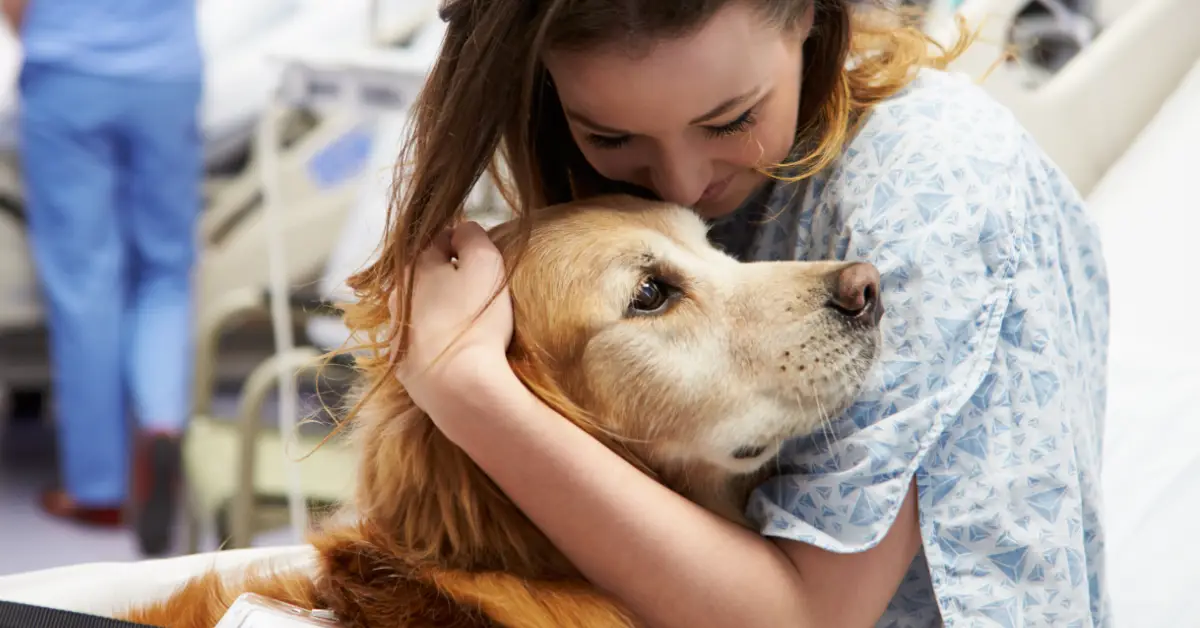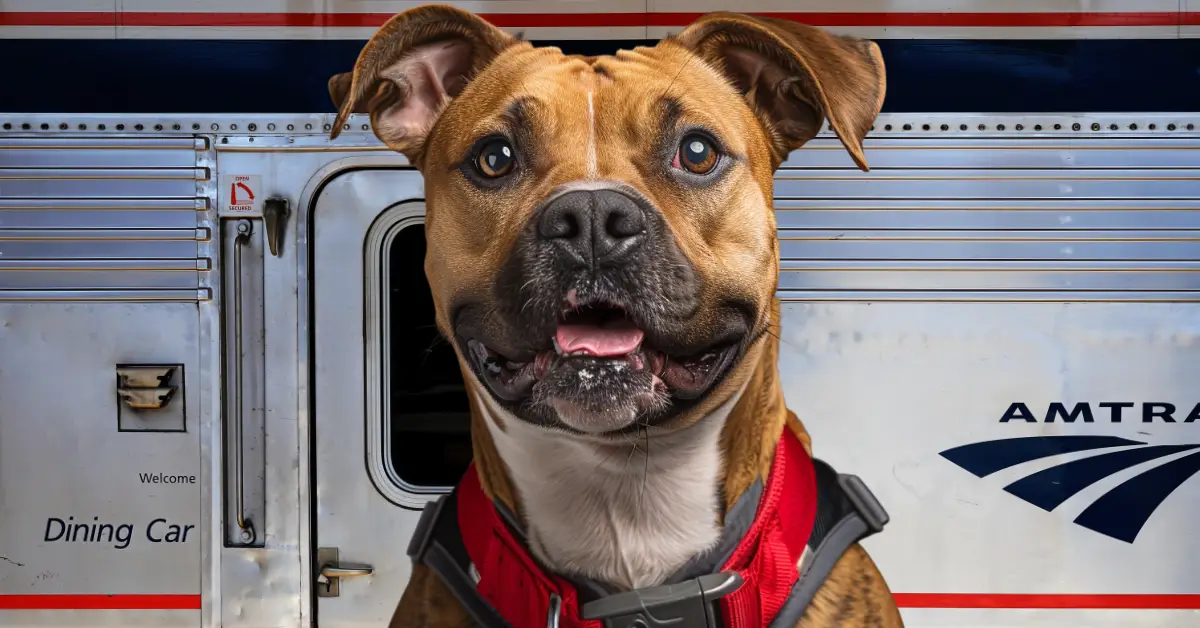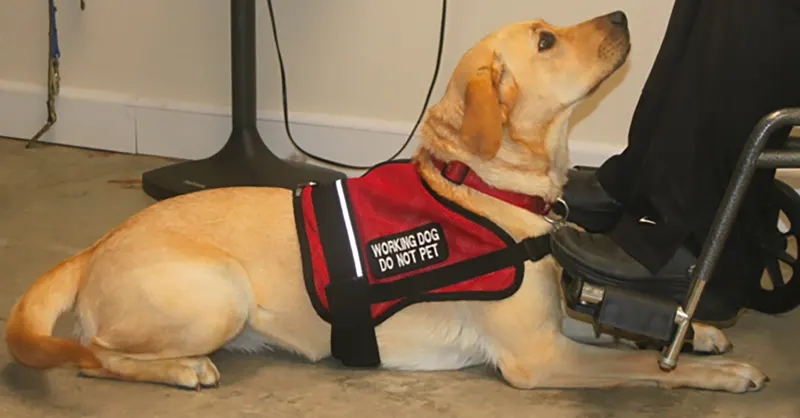Can You Bring a Service Dog to the Hospital?

Yes, you can bring your service dog to the hospital. ADA service dog laws protect your right to be accompanied by your service dog in hospitals, just as in other public places. However, there are some important exceptions you should be aware of — particularly in sterile environments like operating rooms where patient safety concerns take priority.
In this article:
- Where Your Service Dog Can Go in the Hospital
- Where Your Service Dog Cannot Go in Hospitals (and Why)
- When Other Patients’ Needs Come Into Play
- Practical Tips for Bringing Your Service Dog to the Hospital
- What If You Face Resistance?
- Policies at Major U.S. Hospitals
Where Your Service Dog Can Go in the Hospital
Your service dog can accompany you in most hospital areas, including:
- Emergency waiting rooms
- Patient rooms (in most cases)
- Cafeterias and public dining areas
- Hallways and lobbies
- Standard exam rooms
- Physical therapy areas
When you arrive with your service dog, hospital staff are only allowed to ask you two questions for verification:
- “Is this a service dog required because of a disability?”
- “What specific tasks has the dog been trained to perform?”
They cannot demand to see certification, ask about your service dog ADA disability, or request a demonstration of your dog’s skills.
Where Your Service Dog Cannot Go in Hospitals (and Why)
There are a number of places that are off-limits to service dogs for safety and health reasons. For example, your service dog can’t enter truly sterile areas:
- Operating rooms:
Even the cleanest dog carries microorganisms that could cause dangerous surgical infections. The controlled environment in an OR needs to remain as sterile as possible. - Burn units:
Patients with severe burns are extremely vulnerable to infection. Even minor contamination could be life-threatening. - Isolation rooms:
Patients in protective isolation (like those receiving bone marrow transplants or certain cancer treatments) have severely compromised immune systems that can’t risk exposure to outside contaminants.
Some critical care areas may also restrict service dogs:
- ICU settings:
These areas often have limited space and contain life-saving equipment. Your dog might unintentionally disconnect something vital or block quick access during an emergency. - Trauma centers:
During active resuscitations, medical teams need every inch of space and can’t work around a service dog.
Some restrictions are about your dog’s safety as much as patient care:
- MRI suites:
The powerful magnets in MRI machines could harm your dog if they have any metal on their collar or in their body. - Radiation treatment areas:
These pose obvious radiation exposure risks to your dog.

When Other Patients’ Needs Come Into Play
Sometimes, restrictions happen because of other patients. For example, if another patient has severe dog allergies, the hospital will need to accommodate both of you. This might require moving one of you to a different room, creating scheduling workarounds for shared spaces, or using air purifiers to reduce allergens.
Some patients have severe dog phobias that can trigger panic attacks. This isn’t just discomfort — it’s a legitimate medical concern. These phobias can raise blood pressure to dangerous levels, trigger severe anxiety that interferes with treatment, and cause breathing difficulties in already vulnerable patients. In these cases, the hospital might create schedules to keep you and your dog separated from the phobic patient during treatments or transfers.
Patients undergoing treatments that severely suppress their immune systems might need temporary separation from all potential infection sources — including service dogs. This isn’t discrimination because it might be due to medical necessity.
Practical Tips for Bringing Your Service Dog to the Hospital
Before Your Visit
Call the patient advocate office before your visit, as a quick conversation can prevent misunderstandings. Pack smart by bringing waste bags, a portable water bowl, and any comfort items your dog needs. Make sure to groom your dog thoroughly, as a clean, well-groomed dog will face fewer objections. Exercise your dog before the visit, as a less restless dog will behave better during long hospital waits.
During Your Stay
While not legally required, service dog vests, ID cards, harnesses, and tags can be extremely helpful in a hospital setting. They provide instant visual recognition for staff, reducing questions and potential conflicts when you may not feel well enough to explain. A properly labeled vest can help hospital security quickly identify your dog as a service animal at entrances, and colorful “Service Dog” patches make it clear to other patients why your dog is present.
Though hospitals can’t legally demand paperwork, having your dog’s vaccination records and a letter from a healthcare provider, such as a PSD letter, can smooth interactions. This is especially useful during extended stays, when you’ll encounter multiple staff shifts.
In hospitals, consider using a harness with “SERVICE DOG” or “WORKING DOG – DO NOT PET” labels to prevent well-meaning staff and visitors from distracting your dog. Clean, professional-looking equipment helps reinforce your dog’s working status.
Bring someone who can take your dog outside for breaks or watch them during procedures where they can’t join you. Be prepared to educate, as many staff members might not know the rules about service dogs. Stay calm and inform rather than confront. Keep your dog leashed and well-behaved at all times, and understand when separation is necessary for medical reasons.

What If You Face Resistance?
If hospital staff incorrectly try to ban your service dog from areas where it should be allowed:
- Stay calm and politely explain the ADA regulations
- Ask to speak with the hospital’s patient advocate or ADA coordinator
- Clarify whether the restriction is based on a legitimate medical concern
- If necessary, offer to contact the Department of Justice ADA information line
Remember, most access issues stem from misunderstanding rather than intentional discrimination.
Policies at Major U.S. Hospitals
Notable hospitals like the NIH’s Clinical Center and Cedars-Sinai Hospital have information about their animal policies on their websites. All in all, they mostly say the same thing as the federal law.
Clinical Center at the National Institutes of Health (Bethesda, MD)
Service animals are “welcome at and may accompany patients and visitors to the Clinical Center” at the National Institutes of Health in Bethesda, Maryland. The NIH uses the same definition of “service animal” as the ADA and says that the service animal can accompany individuals with a disability, including physical, sensory, psychiatric, intellectual, or other mental disability.
Cedars-Sinai (Los Angeles, CA)
Cedars-Sinai Hospital in Los Angeles, California, allows service animals to access the hospital. Service dogs can accompany patients before and after exams and imaging, but only the patient and medical staff can be in the exam room, imaging room, or recovery room. Imaging devices used by the medical team use ionizing radiation, magnetic fields, radiofrequency, and ultrasound waves, which are hazardous to dogs’ health, so they have to wait in a designated waiting area during the medical exam, imaging, and possibly recovery, if required.
About the Author: The writing team at Service Dog Certifications is made up of folks who really know their stuff when it comes to disability laws and assistance animals. Many of our writers and editors have service dogs themselves and share insights from their own experiences. All of us have a passion for disability rights and animals.
Latest Posts

How Much Should I Exercise My Service Dog?
Like any dog, a service dog needs exercise. While their work to support you involves a certain amount of physical activity, there’s a good chance it’s not enough to keep your dog healthy. The amount and type of exercise needed will depend on your dog’s breed and age. Fortunately, there is a wide range of […]

Read More

Montana’s Emotional Support Animal Laws
Walk through any Montana neighborhood with rental properties, and you’ll likely spot them: the quiet cat watching from a window in a “no pets” building in Bozeman or the pup roaming the lobby of a Missoula apartment complex that doesn’t allow dogs. Emotional support animals exist in a unique legal category that has confused some […]

Read More

Amtrak’s Service Dog Policy in Plain English
Amtrak welcomes service animals, allows them to be on board for free, and offers resources to ensure a positive experience. However, Amtrak has its own rules governing service dogs aboard the train, and it’s important to understand them before purchasing a ticket. We’ll explain Amtrak’s service dog policies in easy-to-understand terms. In this article: Amtrak’s […]

Read More




